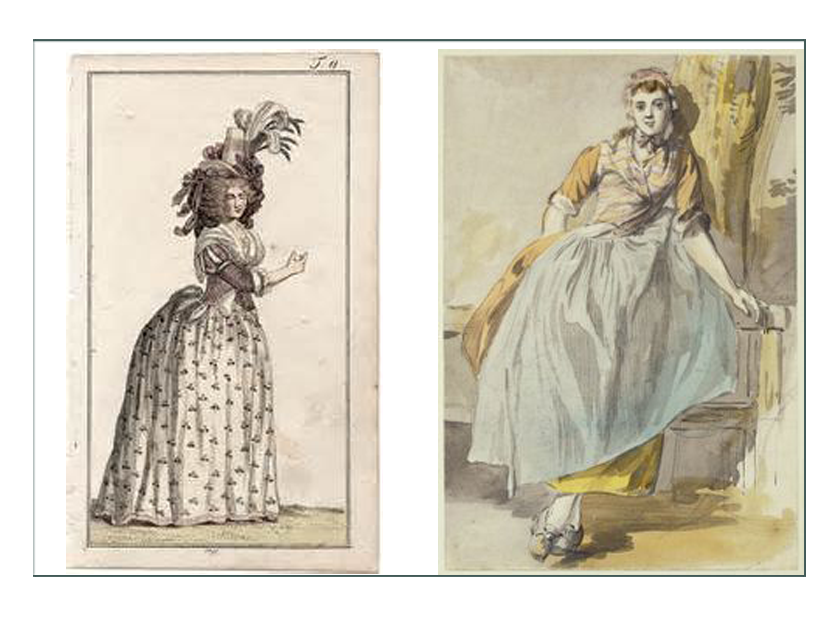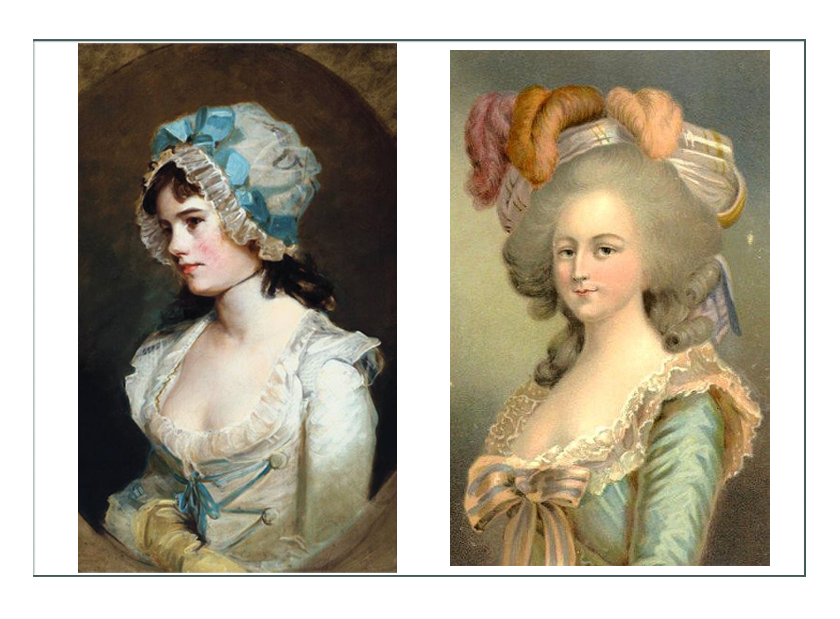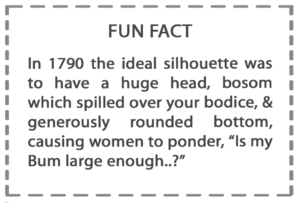
Fashion & Industry affected as a new United States of America repairs & mobilizes:
- Revolutionary War “officially” ended in 1783
- Sewing machine invented and available for mass production
- Only “natural” fabrics: cotton (lawn, Indian print/calicoes, muslin, wool, flax (linen), silk were possible
- start of European industrial revolution – mass production, improvement of spinning and weaving methods
- many imports and much trade made for availability
- invention of cotton gin
- women, even country women did not make their own clothes. They had a tailor in town, or a traveling tailor (by different names). They might repair their petticoat or make a man’s shirt
- tailoring business was all men who had shops in town and lived upstairs until later when women figured out they could make money at it and started tailoring for others out of their homes
- They’d send for things via letter, and the next person coming from town would bring the item out.
- Influence of war and politics in Europe influenced American fashion. France started most trends; in this era, it was Marie Antoinette who was out of favor with everyone, so she retired to a country estate. She developed the “gaulle”, which was basically a sheet draped and belted. This led to a more casual style, although the gaulle was considered too indecent and never made it big in the courts..
- but Marie’s attention to the simplicity and ease of country living led to French fashions such as bringing sheep to the city so women could dress as shepherdesses and pretend to be herding.
- the peasant clothes of England merged with the Antoinette style, and the practicality of it because they could actually move around and climb into carriages and work at a job brought the rise of these less ornamented styles.
- skirts went shorter so women could move in the muck. They wore under and over skirts, so the overskirt could be lifted up out of harm’s way.
- There was a new culture of more cleansiness, and clothes (and people) were washing more often and with harsher soaps. The harsh soaps damaged fabrics, so the style evolved so only whites were exposed to damage regularly. These were cheaper fabrics and could easily be washed.
- Pockets, bigger aprons, and protective hair coverings such as mobcaps became logical for elite women as well as working women, so every social strata wore the basics, but varied in individuality.

- This was a time of the rise of individual expression, which would lead directly after 1800 into the Regency style (after the king who had to have a Regent in power) – which would be the Greek Goddess looking almost naked look.
- Because this “peasant style” prior to the Regency (it doesn’t really have a name) had everyone wearing close to the same thing, the variations became in accessorizing.
- The time prior to 1790 had huge hairstyles that had garish ornamentation such as ships and hair piled 36″ high. This time period saw hair and ornamentation go WIDE instead – with curls on the side, floppy big wide hats, and huge bows.
- Hair was allowed to be natural, maybe cut on the sides with curling papers used for curls around the face – which is a rare time in history for women to do so. It was left long in the back (not cut in the back), although in the Regency period, some women did cut all their hair short in the Greek Style and wore golden bands and such. Cutting the hair did not become popular anywhere in the world until the 1900’s.
- The political world combined with a new ability to travel, trade, and communicate with other countries allowed not only the exchange of information of styles – incorporating Egyptian or other country accessories, colors, patterns, etc. – but also created a fierce rivalry between countries for the sale of goods. Cotton in particular dropped in price because India and England had flooded the market. Cotton was a fabric of choice world wide, because of low cost, availability, new printing methods (stripes, patterns, Indian prints, etc.) and because it was easy to sew and easy to clean. It was also comfortable in warm climates, but in cooler regions, it led to the development of multiple layers of fabrics with coats, jackets, cloaks, and over dresses; styles that lasted over many fashion style changes.
- “The little red cloak” is one fashion item that traveled almost 100 years, and is referenced in literature from “Little Red Riding Hood”, to references in American art and stories.
- at the earlier end of 1790, women were coming off many years of wearing tight corseets, stomachers, and fancy times. They were headed towards “simpler times of individuality”, but were not quite there yet: there were rules.
- Women still had to be covered to the ankles, and they wore dresses. In this period, however, the women’s full figure and sensuality was celebrated with focus on the breasts. Styles of the entire period and into Regency, STARTED with the breast fully exposed either through fabric or peeking out, and then women added more and more creative pieces depending on how retiring they were. Younger women were more apt to flaunt it all, and older women to add things to “cover up”.
- This led to development of larger “fichus”, scarf like coverings predominantly in the finer linens and woolens depending on season and location, that could cover all or part of the neck and decolletage. These could wrap around the waist, or be worn like a shawl.
- “Tuckers” were horizontal pieces of lace or fabric worn to cover the bosom division (note here, in the upcoming Regency period, some would not wear corsets/stays at all, but would use a forerunner of the bra, which was a breast seperater made of metal).

- Awareness of sexuality and expression also demanded a large derriere, so while most women didn’t need them, many did continue to add small bustles in back to make the appearance of a derriere larger.
- They didn’t particularly care if the waist was tiny, although some did continue to cinch in the waist using stays – softer versions of their predecessors (and later relatives that would contort the female body significantly in the end of the 1800’s), which did not have boning, but were more of a support for the breasts and back.
- Stays, which were adjusted through lacing in the back, and put on through clips in the front, were excellent back braces for women doing heavy lifting
- There were many and varied lengths of sleeves, bodices, and petticoats than previous decades. In general, sleeves were elbow length and had added frills for individual expression. Skirts and aprons were shorter, and the dress overall less full, without the pleats and gathers and added features.
- Many women did dress up with trains and fabric coming off the shoulder into a train such as they did in the Courts of Europe, but mostly trains were used for only dress up, and reemerged later in the Regency era.
- Shoes were pumps with 1″ curved heals, and the top open; toes somewhat pointed and curving upwards. For riding or work, an ankle high boot with laces was used.
- Riding habits were closer to what men wore, but still were dresses, although with less fabric, and included the short jackets, or capes, cloaks, and manteaus of the men’s wardrobe.
- Accessories were abundant; most women had only a basic chemise, 2 petticoats, stays, a couple pairs of stockings, a couple pairs of gloves, and only a few dresses. Wealthier women focused on buying a wide range of cloaks, coats, and shawls instead of changing the dress. They would accessorize with buckles and bows to make the clothing look different for different occasions.
- Gloves were always worn unless working or dining, and stockings were of white or black knotted or silk, worn with a garter above the knee.
- Older women wore deeper colors; mauve, black, and some of the new dyes of the era that had been developed or imported, while young maidens enjoyed pastels in greens, yellows, and patterns.
- All women enjoyed lace and ruffles; ribbons and bows on their inner and outer wear, with their overcoats, scarves, and shawls of the best materials possible, yet less extravagant and even more durable and practical.
- In private and in leisure, there were garments similar to the “gaulle” of Marie Antoinette, but history speaks very little of this. Most of fashion history focuses on court trends and politics.
- The best way to determine American fashion history is through paintings and descriptive writing. In the book “The Reshaping of Everyday Life 1790-1940” by Jack Larkin, he describes the day to day people of this era as “A busy, bustling, industrious population”.
- With this industry in mind, fashion for the era’s women is mostly practical, durable, washable, and similar, with individualism expressed through color, pattern, and accessory.

Click here to go to Shelly’s Fashion History page (next)
Click here to go to Shelly’s Design Development page
Click here to go to Shelly’s main page with the finished project
